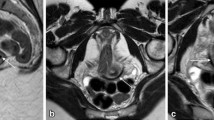Abstract
Purpose
The radiologist can encounter benign significant imaging findings on computed tomography that can be incorrectly interpreted as neoplasm. The authors review several benign findings and demonstrate several methods to differentiate these findings from more sinister pathology.
Conclusion
It is imperative for the radiologist to be cognizant of and how to correctly identify mimickers of pathology so that unnecessary interventions and surgeries are avoided.













Similar content being viewed by others
References
O’Connor AR, Whittaker C (2006) Radiologic findings that mimic malignancy. AJR 187:W357–W364
Singh AK, Levenson RB, Gervais DA, et al. (2007) Dropped gallstones and surgical clips after cholecystectomy: CT assessment. J Comput Assist Tomogr 31(5):758–762
Habib E, Elhadad A (2003) Digestive complications of gallstones lost during laparoscopic cholecystectomy. HPB (Oxford) 5(2):118–122
Atri M, Bonifacio A, Ryan M, et al. (2002) Dropped gallstones post laparoscopic cholecystectomy mimicking peritoneal seeding: CT and ultrasound features. J Comput Assist Tomogr 26(6):1000–1005
Ali MG, Coakley FV, Hricak H, et al. (1999) Complex posttransplantation abnormalities of renal allografts: evaluation with MR imaging. Radiology 211:95–100
Sebastià C, Quiroga S, Boyé R, et al. (2001) Helical CT in renal transplantation: normal findings and early and late complications. Radiographics 21:1103–1117
Amid PK (2004) Radiologic images of meshoma. A new phenomenon causing pain after prosthetic repair of abdominal wall hernias. Arch Surg 139(12):1297–1298
Yeung VH, Pearl JM, Coakley FV, et al. (2008) Computed tomographic appearance of Prolene Hernia System and polypropylene mesh plug inguinal hernia repair. J Comput Assist Tomogr 32(4):529–532
Sella T, Mironov S, Hricak H (2005) Imaging of transposed ovaries in patients with cervical carcinoma. AJR 184:1602–1610
Saksouk FA, Johnson SC (2004) Recognition of the ovaries and ovarian origin of pelvic masses with CT. Radiographics 24(Suppl 1):S133–S146
Wolfson JJ, Stowell DW (1969) Aberrant renal papilla simulating an intrarenal mass. Radiology 93:812–814
Kumar D, Cigtay OS, Klein LH (1977) Aberrant renal papilla. Br J Radiol 50:141–142
Rosenberger A, Abrams HL (1971) Radiology of the thoracic duct. Am J Roentgenol Radium Ther Nucl Med 111:807–820
Pinto PS, Sirlin CB, Andrade-Barreto OA, et al. (2004) Cisterna chyli at routine abdominal MR imaging: a normal anatomic structure in the retrocrural space. Radiographics 24(3):809–817
Smith TR, Grigoropoulos J (2002) The cisterna chili: incidence and characteristics on CT. Clin Imaging 26:18–22
Arrivé L, Azizi L, Lewin M, et al. (2007) MR lymphography of abdominal and retroperitoneal lymphatic vessels. AJR 189(5):1051–1058
Gollub MJ, Castellino RA (1996) The cisterna chyli: a potential mimic of retrocrural lymphadenopathy on CT scans. Radiology 199(2):477–480
Bhatt S, MacLennan G, Dogra V (2007) Renal pseudotumors. AJR 188(5):1380–1387
Yitta S, Hecht EM, Mausner EV, et al. (2011) Normal or abnormal? Demystifying uterine and cervical contrast enhancement at multidetector CT. Radiographics 31(3):647–661
Kim HJ, Byun JH, Park SH, et al. (2007) Focal fatty replacement of the pancreas: usefulness of chemical shift MRI. AJR 188(2):429–432
Isserow JA, Siegelman ES, Mammone J (1999) Focal fatty infiltration of the pancreas: MR characterization with chemical shift imaging. AJR 173(5):1263–1265
Rha SE, Byun JY, Jung SE, et al. (2004) The renal sinus: pathologic spectrum and multimodality imaging approach. Radiographics 24(Suppl 1):S117–S131
Shin SM, Kim S, Lee JW, et al. (2007) Biliary abnormalities associated with portal biliopathy: evaluation on MR cholangiography. AJR 188(4):W341–W347
Brady TM, Gross BH, Glazer GM, et al. (1985) Adrenal pseudomasses due to varices: angiographic-CT-MRI-pathologic correlations. AJR 145(2):301–304
Vahidid K, Joe BN, Meng M, et al. (2007) Review of atypical pelvic masses on CT and MRI: expanding the differential diagnosis. Clin Imaging 31:406–413
Georgiades CS, Neyman EG, Francis IR, et al. (2002) Typical and atypical presentations of extramedullary hemopoiesis. AJR 179(5):1239–1243
Gupta P, Naran A, Auh YH, et al. (2004) Focal intrahepatic extramedullary hematopoiesis presenting as fatty lesions. AJR 182(4):1031–1032
Surabhi VR, Menias C, Prasad SR, et al. (2008) Neoplastic and non-neoplastic proliferative disorders of the perirenal space: cross-sectional imaging findings. Radiographics 28(4):1005–1017
Choi H, David CL, Katz RL, et al. (2004) Case 69: extramedullary hematopoiesis. Radiology 231(1):52–56
Fleming CR, Dickson ER, Harrison EG (1976) Splenosis: autotransplantation of splenic tissue. Am J Med 61:414–419
Pumberger W, Wiesbauer P, Leitha T (2001) Splenosis mimicking tumor recurrence in renal cell carcinoma: detection on selective spleen scintigraphy. J Pediatr Surg 36:1089–1091
Malik UF, Martin MR, Patel R, et al. (2010) Parenchymal thoracic splenosis: history and nuclear imaging without invasive procedures may provide diagnosis. J Clin Med Res 2(4):180–184
Acknowledgments
Christopher J. Lisanti receives royalties from Lippincott, Williams and Wilkins.




